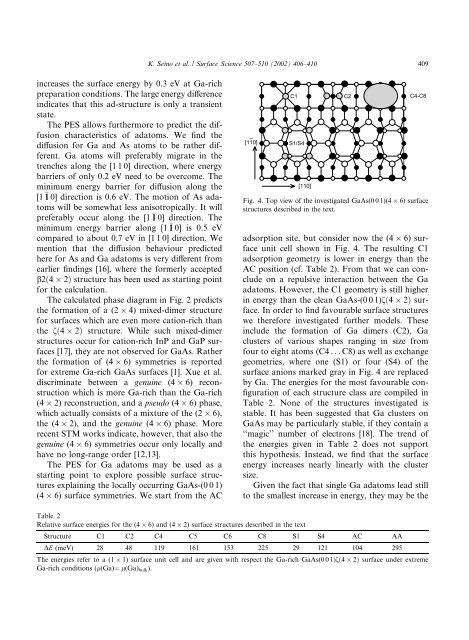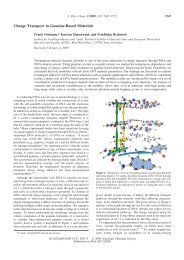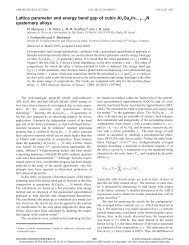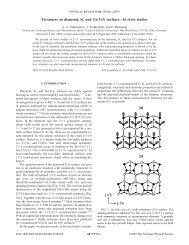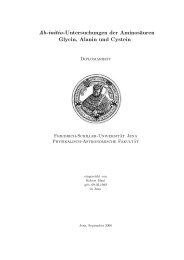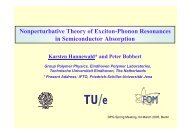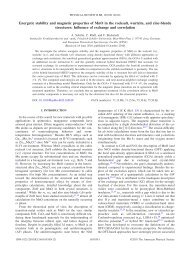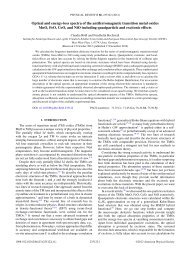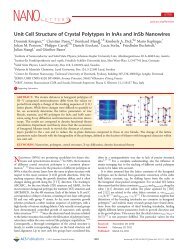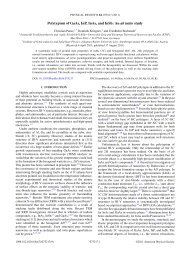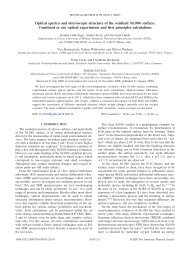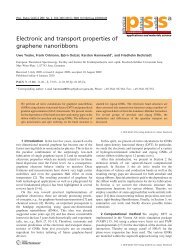Structure and energetics of Ga-rich GaAs(001) surfaces - Institut für ...
Structure and energetics of Ga-rich GaAs(001) surfaces - Institut für ...
Structure and energetics of Ga-rich GaAs(001) surfaces - Institut für ...
You also want an ePaper? Increase the reach of your titles
YUMPU automatically turns print PDFs into web optimized ePapers that Google loves.
K. Seino et al. / Surface Science 507–510 (2002) 406–410 409<br />
increases the surface energy by 0.3 eV at <strong>Ga</strong>-<strong>rich</strong><br />
preparation conditions. The large energy difference<br />
indicates that this ad-structure is only a transient<br />
state.<br />
The PES allows furthermore to predict the diffusion<br />
characteristics <strong>of</strong> adatoms. We find the<br />
diffusion for <strong>Ga</strong> <strong>and</strong> As atoms to be rather different.<br />
<strong>Ga</strong> atoms will preferably migrate in the<br />
trenches along the [1 1 0] direction, where energy<br />
barriers <strong>of</strong> only 0.2 eV need to be overcome. The<br />
minimum energy barrier for diffusion along the<br />
[1 1 0] direction is 0.6 eV. The motion <strong>of</strong> As adatoms<br />
will be somewhat less anisotropically. It will<br />
preferably occur along the [1 1 0] direction. The<br />
minimum energy barrier along [1 1 0] is 0.5 eV<br />
compared to about 0.7 eV in [1 1 0] direction. We<br />
mention that the diffusion behaviour predicted<br />
here for As <strong>and</strong> <strong>Ga</strong> adatoms is very different from<br />
earlier findings [16], where the formerly accepted<br />
b2ð4 2Þ structure has been used as starting point<br />
for the calculation.<br />
The calculated phase diagram in Fig. 2 predicts<br />
the formation <strong>of</strong> a (2 4) mixed-dimer structure<br />
for <strong>surfaces</strong> which are even more cation-<strong>rich</strong> than<br />
the fð4 2Þ structure. While such mixed-dimer<br />
structures occur for cation-<strong>rich</strong> InP <strong>and</strong> <strong>Ga</strong>P <strong>surfaces</strong><br />
[17], they are not observed for <strong>Ga</strong>As. Rather<br />
the formation <strong>of</strong> (4 6) symmetries is reported<br />
for extreme <strong>Ga</strong>-<strong>rich</strong> <strong>Ga</strong>As <strong>surfaces</strong> [1]. Xue et al.<br />
discriminate between a genuine (4 6) reconstruction<br />
which is more <strong>Ga</strong>-<strong>rich</strong> than the <strong>Ga</strong>-<strong>rich</strong><br />
(4 2) reconstruction, <strong>and</strong> a pseudo (4 6) phase,<br />
which actually consists <strong>of</strong> a mixture <strong>of</strong> the (2 6),<br />
the (4 2), <strong>and</strong> the genuine (4 6) phase. More<br />
recent STM works indicate, however, that also the<br />
genuine (4 6) symmetries occur only locally <strong>and</strong><br />
have no long-range order [12,13].<br />
The PES for <strong>Ga</strong> adatoms may be used as a<br />
starting point to explore possible surface structures<br />
explaining the locally occurring <strong>Ga</strong>As-(0 0 1)<br />
(4 6) surface symmetries. We start from the AC<br />
Fig. 4. Top view <strong>of</strong> the investigated <strong>Ga</strong>As(0 0 1)(4 6) surface<br />
structures described in the text.<br />
adsorption site, but consider now the (4 6) surface<br />
unit cell shown in Fig. 4. The resulting C1<br />
adsorption geometry is lower in energy than the<br />
AC position (cf. Table 2). From that we can conclude<br />
on a repulsive interaction between the <strong>Ga</strong><br />
adatoms. However, the C1 geometry is still higher<br />
in energy than the clean <strong>Ga</strong>As-(0 0 1)fð4 2Þ surface.<br />
In order to find favourable surface structures<br />
we therefore investigated further models. These<br />
include the formation <strong>of</strong> <strong>Ga</strong> dimers (C2), <strong>Ga</strong><br />
clusters <strong>of</strong> various shapes ranging in size from<br />
four to eight atoms (C4 ...C8) as well as exchange<br />
geometries, where one (S1) or four (S4) <strong>of</strong> the<br />
surface anions marked gray in Fig. 4 are replaced<br />
by <strong>Ga</strong>. The energies for the most favourable configuration<br />
<strong>of</strong> each structure class are compiled in<br />
Table 2. None <strong>of</strong> the structures investigated is<br />
stable. It has been suggested that <strong>Ga</strong> clusters on<br />
<strong>Ga</strong>As may be particularly stable, if they contain a<br />
‘‘magic’’ number <strong>of</strong> electrons [18]. The trend <strong>of</strong><br />
the energies given in Table 2 does not support<br />
this hypothesis. Instead, we find that the surface<br />
energy increases nearly linearly with the cluster<br />
size.<br />
Given the fact that single <strong>Ga</strong> adatoms lead still<br />
to the smallest increase in energy, they may be the<br />
Table 2<br />
Relative surface energies for the (4 6) <strong>and</strong> (4 2) surface structures described in the text<br />
<strong>Structure</strong> C1 C2 C4 C5 C6 C8 S1 S4 AC AA<br />
DE (meV) 28 48 119 161 153 225 29 121 104 295<br />
The energies refer to a (1 1) surface unit cell <strong>and</strong> are given with respect the <strong>Ga</strong>-<strong>rich</strong> <strong>Ga</strong>As(0 0 1)fð4 2Þ surface under extreme<br />
<strong>Ga</strong>-<strong>rich</strong> conditions (l(<strong>Ga</strong>)¼ l(<strong>Ga</strong>) bulk ).


